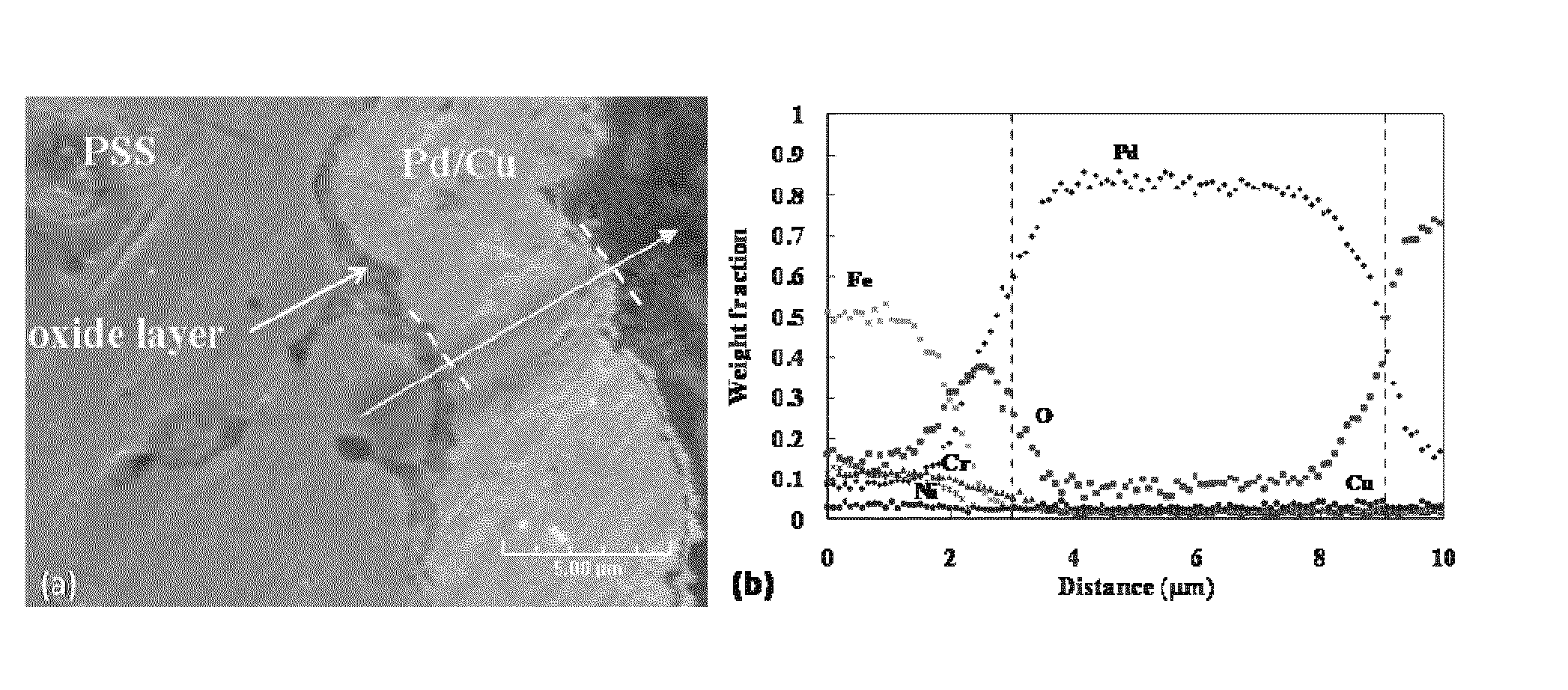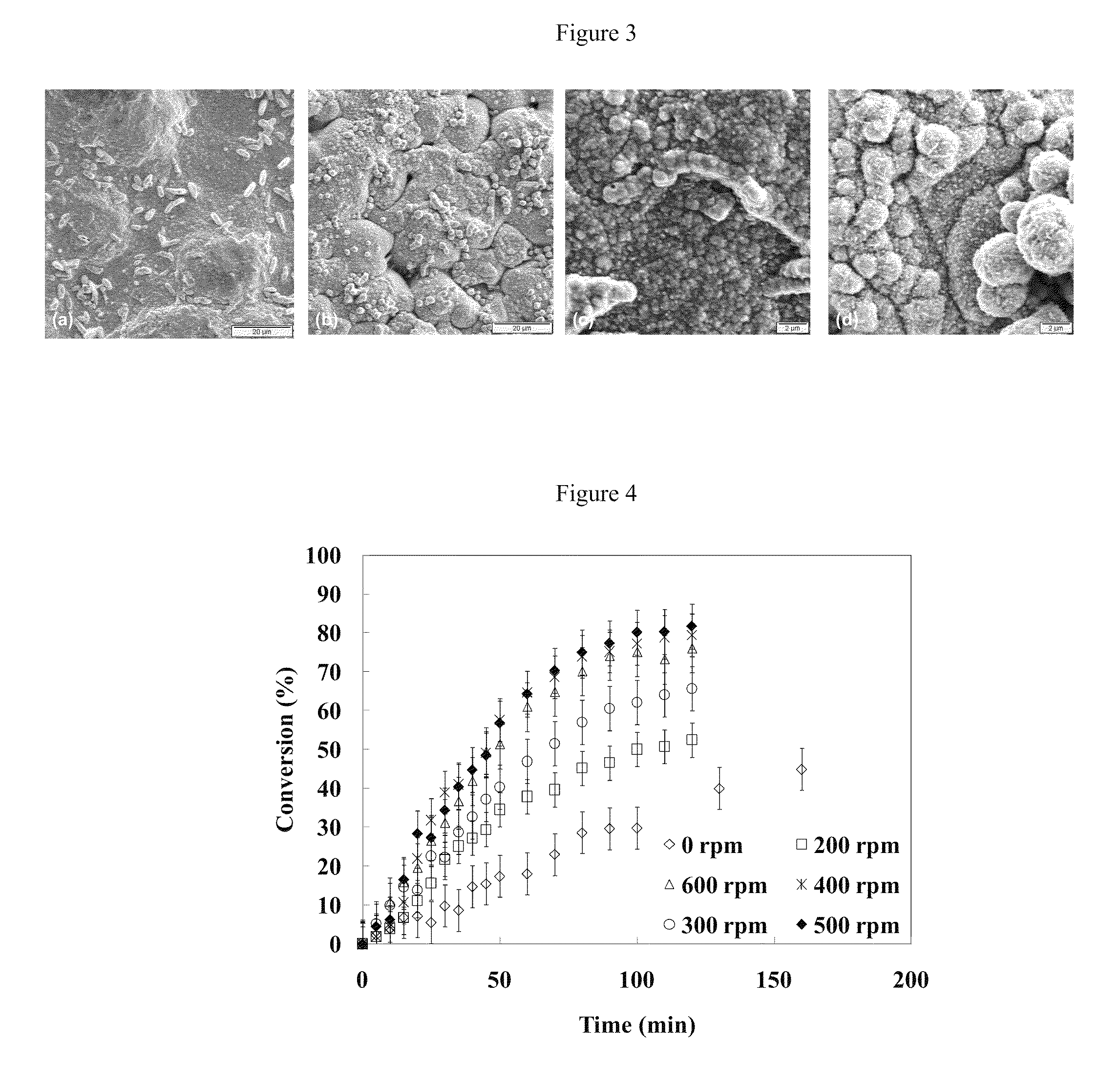High permeance sulfur tolerant Pd/Cu alloy membranes
a technology of pd/cu alloy membrane and high permeance, which is applied in the direction of membranes, liquid/solution decomposition chemical coatings, separation processes, etc., can solve the problems of reducing hydrogen permeance, fcc pd/cu membrane, irreparable damage, etc., and achieves less annealing time and temperature, not sustain a significant loss of permeance, and greater tolerance for sulfur
- Summary
- Abstract
- Description
- Claims
- Application Information
AI Technical Summary
Benefits of technology
Problems solved by technology
Method used
Image
Examples
example 1
Dense Pd Layer Formation (Tubular Membrane Only)
[0043]Pd was plated until no plating solution was found in the interior of the tube indicating that the membrane was “liquid dense,” usually after 2-3 plating rounds. The membrane would then be rinsed with deionized water and dried at 120° C. overnight. The He permeance would be measured and the membrane plated again. After the membrane was liquid dense, the membrane was plated with a vacuum by attaching the tube side to an aspirator or vacuum pump. A slight vacuum was used at first (550 torr) and if the level of the plating solution did not decrease, indicating that the membrane was “liquid dense”, the vacuum was increased to 380 torr. If the membrane was “liquid dense” at 380 torr then the vacuum was then increased to 75 torr to block the remaining pinholes. Between each round of plating, the membrane was dried and the He permeance measured. If the He leak of the membrane could not be detected at ΔP=2.3 bar at room temperature, the m...
example 2
Cu Plating
[0044]In order to form a Pd / Cu bi-layer, a plating bath was used to plate Cu onto the coupons. Table 1 lists the Cu plating bath composition, as well as the composition of the Pd galvanic displacement bath, which is described in greater detail below.
[0045]
TABLE 1Plating and galvanic displacement bath compositions and conditionsPd galvanicStandardDilute CudisplacementPd bathCu bathbathbathPd(NH3)4Cl2•H2O (g / l)4CuSO4•5H2O (g / l)252.5PdCl2 (g / l)1.0Na2EDTA•2H2O (g / l)40.147.54.75NH4OH (28%) (ml / l)198H2NNH2 (98%) (ml / l)0.19H2CO (37%) (ml / l)252.5EDA (ppm)11211.2K4Fe(CN)6•3H2O (ppm)353.5(C2H5)2NCS2Na•3H2O50.5(ppm)pH10-1112.012.72Temperature (° C.)6020-2520-2520-25
[0046]After the Cu plating solution was prepared and the pH adjusted by adding concentrated NaOH or KOH solution, the activated support was immersed for 10-60 minutes at room temperature, depending on the desired thickness. After plating Cu, the supports were immediately immersed in 0.01 M HCl to neutralize any residual pl...
example 3
Galvanic Displacement of Cu by Pd
[0057]In order to form the Pd / Cu / Pd tri-layer, a galvanic displacement step was performed. During the galvanic displacement step, Pd is deposited while Cu is displaced. The samples were first plated with roughly 1.5 μm of Cu. In order to conduct the galvanic displacement, the samples were immersed in a PdCl2 solution that was agitated at varying speeds for 1.5 hours. The composition of the Pd galvanic displacement bath is described in Table 1. The galvanic displacement of Cu occurs according to the following electrochemical reaction where the Pd2+ ion in solution replaces the Cu metal on the substrate:
[0058]Pd2++2e-→Pd0E0=0.951V+Cu2++2e-→Cu0E0=0.3419VPd2++Cu0→Pd0+Cu2+E0=0.6091V
[0059]FIG. 6 is a secondary electron imaging (SEI) surface micrograph at 3000× of samples plated with Cu and further displaced by Pd with (a) an unagitated bath, and with a bath agitated at speeds of (b) 200 rpm, (c) 400 rpm, and (d) 600 rpm. For the images shown...
PUM
| Property | Measurement | Unit |
|---|---|---|
| temperature | aaaaa | aaaaa |
| thickness | aaaaa | aaaaa |
| thickness | aaaaa | aaaaa |
Abstract
Description
Claims
Application Information
 Login to View More
Login to View More - R&D
- Intellectual Property
- Life Sciences
- Materials
- Tech Scout
- Unparalleled Data Quality
- Higher Quality Content
- 60% Fewer Hallucinations
Browse by: Latest US Patents, China's latest patents, Technical Efficacy Thesaurus, Application Domain, Technology Topic, Popular Technical Reports.
© 2025 PatSnap. All rights reserved.Legal|Privacy policy|Modern Slavery Act Transparency Statement|Sitemap|About US| Contact US: help@patsnap.com



